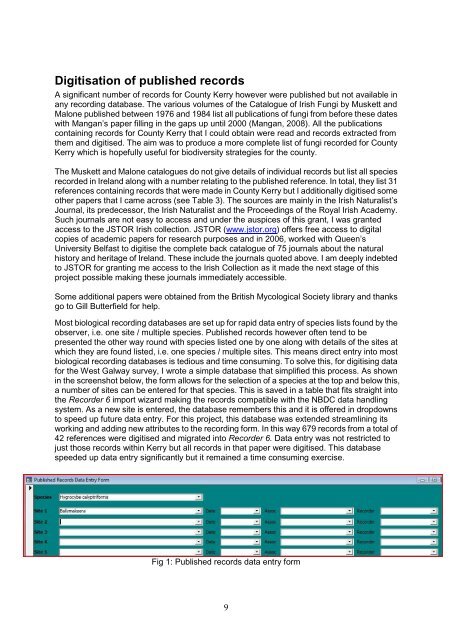North Kerry Waxcap Survey 2012 - the Northern Ireland Fungus Group
North Kerry Waxcap Survey 2012 - the Northern Ireland Fungus Group
North Kerry Waxcap Survey 2012 - the Northern Ireland Fungus Group
You also want an ePaper? Increase the reach of your titles
YUMPU automatically turns print PDFs into web optimized ePapers that Google loves.
Digitisation of published records<br />
A significant number of records for County <strong>Kerry</strong> however were published but not available in<br />
any recording database. The various volumes of <strong>the</strong> Catalogue of Irish Fungi by Muskett and<br />
Malone published between 1976 and 1984 list all publications of fungi from before <strong>the</strong>se dates<br />
with Mangan’s paper filling in <strong>the</strong> gaps up until 2000 (Mangan, 2008). All <strong>the</strong> publications<br />
containing records for County <strong>Kerry</strong> that I could obtain were read and records extracted from<br />
<strong>the</strong>m and digitised. The aim was to produce a more complete list of fungi recorded for County<br />
<strong>Kerry</strong> which is hopefully useful for biodiversity strategies for <strong>the</strong> county.<br />
The Muskett and Malone catalogues do not give details of individual records but list all species<br />
recorded in <strong>Ireland</strong> along with a number relating to <strong>the</strong> published reference. In total, <strong>the</strong>y list 31<br />
references containing records that were made in County <strong>Kerry</strong> but I additionally digitised some<br />
o<strong>the</strong>r papers that I came across (see Table 3). The sources are mainly in <strong>the</strong> Irish Naturalist’s<br />
Journal, its predecessor, <strong>the</strong> Irish Naturalist and <strong>the</strong> Proceedings of <strong>the</strong> Royal Irish Academy.<br />
Such journals are not easy to access and under <strong>the</strong> auspices of this grant, I was granted<br />
access to <strong>the</strong> JSTOR Irish collection. JSTOR (www.jstor.org) offers free access to digital<br />
copies of academic papers for research purposes and in 2006, worked with Queen’s<br />
University Belfast to digitise <strong>the</strong> complete back catalogue of 75 journals about <strong>the</strong> natural<br />
history and heritage of <strong>Ireland</strong>. These include <strong>the</strong> journals quoted above. I am deeply indebted<br />
to JSTOR for granting me access to <strong>the</strong> Irish Collection as it made <strong>the</strong> next stage of this<br />
project possible making <strong>the</strong>se journals immediately accessible.<br />
Some additional papers were obtained from <strong>the</strong> British Mycological Society library and thanks<br />
go to Gill Butterfield for help.<br />
Most biological recording databases are set up for rapid data entry of species lists found by <strong>the</strong><br />
observer, i.e. one site / multiple species. Published records however often tend to be<br />
presented <strong>the</strong> o<strong>the</strong>r way round with species listed one by one along with details of <strong>the</strong> sites at<br />
which <strong>the</strong>y are found listed, i.e. one species / multiple sites. This means direct entry into most<br />
biological recording databases is tedious and time consuming. To solve this, for digitising data<br />
for <strong>the</strong> West Galway survey, I wrote a simple database that simplified this process. As shown<br />
in <strong>the</strong> screenshot below, <strong>the</strong> form allows for <strong>the</strong> selection of a species at <strong>the</strong> top and below this,<br />
a number of sites can be entered for that species. This is saved in a table that fits straight into<br />
<strong>the</strong> Recorder 6 import wizard making <strong>the</strong> records compatible with <strong>the</strong> NBDC data handling<br />
system. As a new site is entered, <strong>the</strong> database remembers this and it is offered in dropdowns<br />
to speed up future data entry. For this project, this database was extended streamlining its<br />
working and adding new attributes to <strong>the</strong> recording form. In this way 679 records from a total of<br />
42 references were digitised and migrated into Recorder 6. Data entry was not restricted to<br />
just those records within <strong>Kerry</strong> but all records in that paper were digitised. This database<br />
speeded up data entry significantly but it remained a time consuming exercise.<br />
Fig 1: Published records data entry form<br />
9


